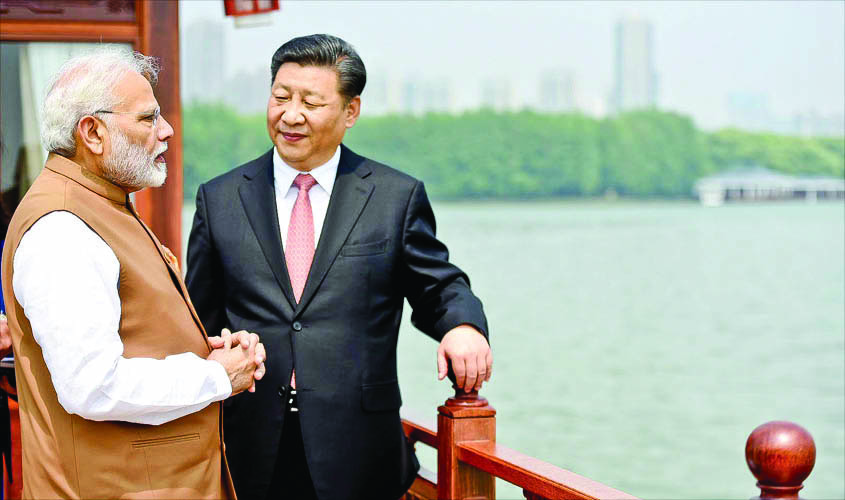China has land borders with 14 countries. It has resolved its border issues with all other countries, but not with India.
India and China share a 3,488 km long border, which is a combination of the MacMahon Line in the east, the Johnson Line in the west, some clearly demarcated stretches of the International Border and some unresolved areas of Line of Actual Control (LAC) in northeast, Uttarakhand and Ladakh. It is in these unresolved areas that the Indian and Chinese Armies come face to face sometimes while carrying out border patrols.
Let us also examine a couple of relevant geographical facts. China is in illegal occupation of a large part of J&K—Aksai Chin, an area of 33,500 sq km and Shaksgam Valley, 5,180 sq km of territory in POK, which Pakistan had illegally ceded to China in 1963. Both these areas are important to China for passage of the Karakoram Highway, which is a part of the high profile linkage of China Pakistan Economic Corridor.
Another less talked of fact has been analysed well by Iqbal Chand Malhotra and Maroof Raza in their book, Kashmir: The Untold Story. Aksai Chin region of Ladakh and the Tarim basin, which lies to its Northeast in Southern Sinkiang are a very resource rich territory with rich deposits of thorium, beryllium and uranium. Moreover, Lake Lop Nor, the site of the Chinese nuclear testing facility, is also fed by the Tarim river. The two main tributaries of the Tarim river are the Karkash river originating in Aksai Chin and the Shaksgam river originating in the Shaksgam valley. China also needs to harness the waters of Himalayas for the giant polysilicon factory near Kashgar in Sinkiang, as microprocessors require vast amounts of freshwater.
These facts help us understand why China is so sensitive about this region.
China has land borders with 14 countries. It has resolved its border issues with all other countries, but not with India. Is it to leverage unresolved border issues as pressure points when India and China are competing for space in different domains like economy, oceans, regional order, space, cyber, multinational arrangements and importantly, the territories in POK and Aksai Chin? Every three to four years we see a flare up—in 2013 it was in Depsang, Chumar in 2014, Dolam plateau in 2017, and the current issue at Galwan and Finger area near Pangong Tso.
At a tactical level, China objects to improvement in our road infrastructure near the borders. While they have created better road infrastructure on their side of the border, which gives them a mobilisation advantage, India started road construction rather late, i.e. in 2005. The Chinese side is loath to see the mobilisation differential being narrowed.
Is there also a larger construct to their design? Should we not have expected a strong reaction from China after dilution of Article 370 and bifurcation of J&K, as CPEC passes through Gilgit-Baltistan and we have discussed Chinese sensitivity to this? Financial safeguards announced against Chinese investments during the corona crisis could be another irritant, as well as our increasing cooperation with the US, with whom their relationship has hit an all-time low.
Despite all the difference and stakes, India and China have managed the border issues rather well by maintaining communications through established diplomatic and military channels. Several agreements have been signed between the two countries in 1993, 1996, 2005, 2012 and 2013 for maintenance of peace at the LAC and for confidence-building measures. Both sides have identified 23 flash points. The key lies in resolving the LAC at the contentious points, for which 22 rounds of meetings have been held. But when it comes to exchange of maps, the Chinese side is reluctant to do so in Ladakh. Even in the east, what they accept on ground, they don’t abide by, politically.
To manage the border issues better, we need to resolutely continue our capacity building in terms of road
How should we move towards a solution? Instead of getting comfortable in cycles of ups and downs and then congratulating ourselves on managing without escalating, the need is to move towards a strategy to resolve issues. The problem of LAC in Ladakh cannot be resolved only at the LAC in Ladakh. It requires an all-of-government approach, with diplomatic, economic and political elements plugging in suitably. India should strengthen its own capacities to defend our borders, and beyond borders we should form part of engagements, if not alliances, where there is convergence of interests. For instance, we could strengthen our relationship with the Indo-China and other such countries. We have a vibrant relationship with Vietnam, which is the only other country with which China has an active territorial dispute, albeit in the sea. However, we could rejuvenate our linkages with Cambodia and Laos, as a part of the Act East policy. Our engagement with forums like Quad, AIFTA, RCEP and more need to be seen in this light. There must be other linkages that experts could identify.
We will do well to develop a strategy for strengthening capacities to safeguard our borders and interests at home, and create linkages beyond borders as our adversary is doing. Then the leadership on both sides can think of rejuvenating resolution of borders, including the bold step of bigger give and take in the Northeast and Ladakh sectors, as was contemplated several years ago.
Lt General Satish Dua is a former Corps Commander in Kashmir, who retired as Chief of Integrated Defence Staff. Views expressed are personal.

